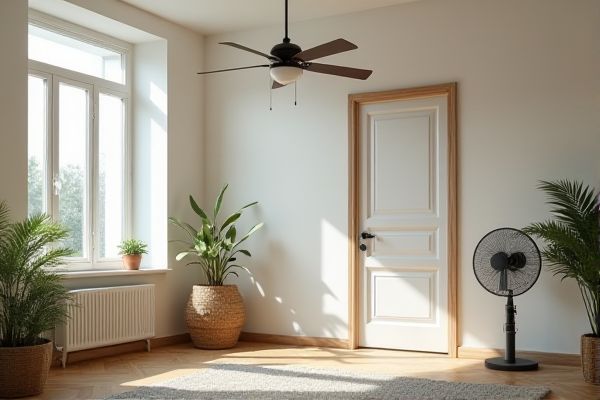
Ceiling fans provide consistent, energy-efficient air circulation by circulating air across a wider area, making them ideal for cooling entire rooms, while portable fans offer flexibility and convenience for targeted cooling that can be easily moved from space to space. Explore this article to discover which fan best suits Your cooling needs and living space.
Table of Comparison
| Feature | Ceiling Fan | Portable Fan |
|---|---|---|
| Installation | Fixed, requires mounting on ceiling | No installation, easy to move anywhere |
| Portability | Not portable | Highly portable |
| Air Circulation | Widespread, covers entire room | Focused, covers smaller areas |
| Energy Consumption | Low to moderate | Low |
| Power Source | Electricity, wired | Electricity or battery-powered |
| Noise Level | Low noise | Varies, can be noisier |
| Cost | Higher initial cost | Lower initial cost |
| Space Requirement | Ceiling space needed | Minimal floor or desk space |
| Best Use | Permanent cooling for rooms | Temporary or spot cooling |
Introduction to Ceiling Fans and Portable Fans
Ceiling fans offer permanent, energy-efficient air circulation ideal for cooling larger rooms, while portable fans provide flexible, movable airflow solutions suitable for personal comfort in various spaces. Ceiling fans typically utilize blades mounted on a fixed fixture to distribute air evenly from above, maximizing room coverage. Portable fans like tower or desk models deliver targeted ventilation, allowing you to adjust positioning based on your immediate cooling needs.
Key Differences Between Ceiling Fans and Portable Fans
Ceiling fans provide consistent, energy-efficient air circulation by mounting overhead and covering a larger area, making them ideal for long-term cooling in fixed spaces. Portable fans offer mobility, easy storage, and focused airflow for personal use, suitable for spot cooling in various locations. Unlike ceiling fans, portable fans require minimal installation but typically generate less airflow and are less effective in cooling entire rooms.
Energy Efficiency Comparison
Ceiling fans typically consume between 15 to 90 watts depending on size and speed, making them more energy-efficient for continuous use in cooling larger areas compared to portable fans, which often use 40 to 100 watts. Portable fans provide targeted airflow and flexibility but can be less efficient when used to cool entire rooms due to their limited range. Energy Star-rated ceiling fans offer enhanced efficiency by using advanced motor technology and aerodynamic blade designs, lowering electricity consumption and cooling costs.
Air Circulation and Cooling Performance
Ceiling fans provide consistent, energy-efficient air circulation by distributing air evenly across an entire room, creating a cooling breeze that enhances comfort without lowering room temperature. Portable fans deliver targeted airflow, ideal for personal cooling and flexibility, but their limited range results in less effective air circulation for larger spaces. For optimal cooling performance, ceiling fans are better suited to maintain ambient air movement, while portable fans offer adjustable, immediate airflow focused on individual use.
Installation and Setup Requirements
Ceiling fans require professional installation involving mounting to the ceiling, electrical wiring, and sometimes additional support for weight and balance, making setup more complex and time-consuming. Portable fans offer a plug-and-play solution with minimal setup, requiring only electrical outlet access and no permanent mounting. The choice between the two depends on space, mobility needs, and willingness to handle electrical installations.
Space and Design Considerations
Ceiling fans save valuable floor space and integrate seamlessly into a room's design, offering a permanent cooling solution without clutter. Portable fans provide flexibility and can be moved between rooms, ideal for temporary or targeted airflow in smaller spaces. Your choice depends on balancing fixed installation with spatial efficiency against the convenience of mobility and design adaptability.
Noise Levels and Comfort
Ceiling fans typically operate at lower noise levels due to their fixed installation and larger blades, providing consistent and gentle airflow that enhances overall room comfort. Portable fans often generate more noise because of their smaller size and higher RPM, which can be disruptive in quiet settings. For optimal comfort and minimal noise disruption, ceiling fans are ideal for continuous use in bedrooms or living areas, while portable fans are better suited for temporary, targeted cooling.
Maintenance and Longevity
Ceiling fans typically require less frequent maintenance than portable fans, with occasional cleaning and lubrication extending their lifespan significantly. Portable fans often need more regular cleaning due to dust buildup on blades and grills, and their compact motors may wear out faster than those in ceiling fans. Choosing a ceiling fan can enhance your home's airflow efficiency while reducing the long-term cost and effort associated with upkeep.
Cost Analysis: Initial Investment and Operation
Ceiling fans generally require a higher initial investment, ranging from $100 to $300, compared to portable fans, which typically cost between $20 and $100. In terms of operation, ceiling fans are more energy-efficient, consuming about 15 to 90 watts per hour, whereas portable fans can use between 30 and 100 watts, leading to slightly higher electricity bills over time. Maintenance costs for ceiling fans may also be higher due to installation and occasional repairs, while portable fans offer lower upkeep with easy replacement options.
Choosing the Right Fan for Your Needs
Ceiling fans provide consistent airflow across an entire room and are ideal for long-term cooling solutions, while portable fans offer flexibility and easy repositioning for targeted airflow. If you need a stationary fan with energy efficiency and quiet operation, ceiling fans are the optimal choice; for temporary or personal cooling, portable fans excel due to their compact design. Assess your space size, cooling preferences, and installation capabilities to choose the right fan for your needs.
 homyna.com
homyna.com